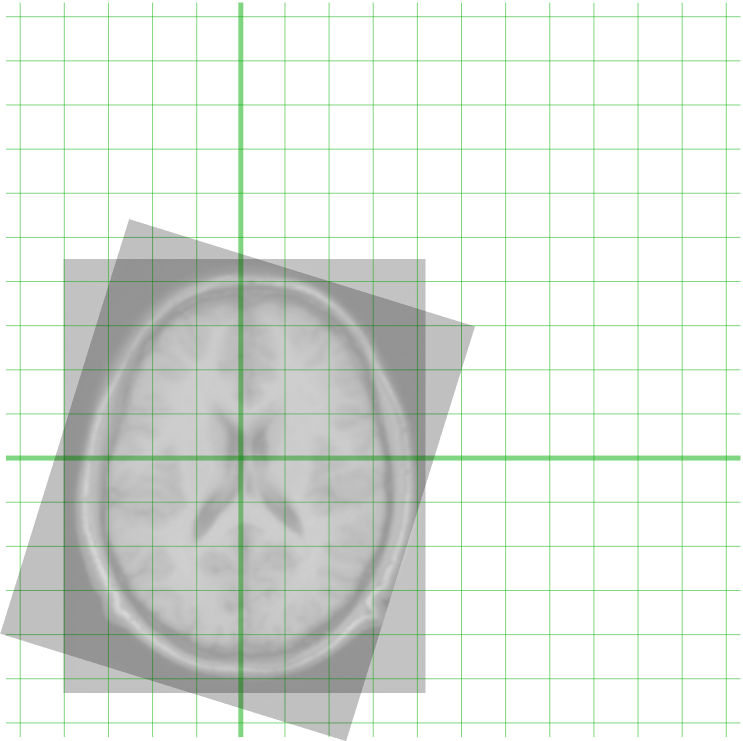|
Inverse Consistency
In image registration, inverse consistency measures the consistency of mappings between images produced by a registration algorithm. The inverse consistency error, introduced by Christiansen and Johnson in 2001, quantifies the distance between the composition of the mappings from each image to the other, produced by the registration procedure, and the identity function, and is used as a regularisation constraint in the loss function of many registration algorithms to enforce consistent mappings.Christiansen and Johnson (2001) Inverse consistency is necessary for good image registration but it is not sufficient, since a mapping can be perfectly consistent but not register the images at all.Rohlfing (2012) Definition Image registration is the process of establishing a common coordinate system between two images, and given two images : \begin I_1: \Omega_1 \to \mathbb \\ I_2: \Omega_2 \to \mathbb \end registering a source image I_1 to a target image I_2 consists of determin ... [...More Info...] [...Related Items...] OR: [Wikipedia] [Google] [Baidu] |
Image Registration
Image registration is the process of transforming different sets of data into one coordinate system. Data may be multiple photographs, data from different sensors, times, depths, or viewpoints. It is used in computer vision, medical imaging, military automatic target recognition, and compiling and analyzing images and data from satellites. Registration is necessary in order to be able to compare or integrate the data obtained from these different measurements. Algorithm classification Intensity-based vs feature-based Image registration or image alignment algorithms can be classified into intensity-based and feature-based.A. Ardeshir Goshtasby2-D and 3-D Image Registration for Medical, Remote Sensing, and Industrial Applications Wiley Press, 2005. One of the images is referred to as the ''moving'' or ''source'' and the others are referred to as the ''target'', ''fixed'' or ''sensed'' images. Image registration involves spatially transforming the source/moving image(s) to align ... [...More Info...] [...Related Items...] OR: [Wikipedia] [Google] [Baidu] |
Identity Function
Graph of the identity function on the real numbers In mathematics, an identity function, also called an identity relation, identity map or identity transformation, is a function that always returns the value that was used as its argument, unchanged. That is, when is the identity function, the equality is true for all values of to which can be applied. Definition Formally, if is a set, the identity function on is defined to be a function with as its domain and codomain, satisfying In other words, the function value in the codomain is always the same as the input element in the domain . The identity function on is clearly an injective function as well as a surjective function, so it is bijective. The identity function on is often denoted by . In set theory, where a function is defined as a particular kind of binary relation, the identity function is given by the identity relation, or ''diagonal'' of . Algebraic properties If is any function, then we have ... [...More Info...] [...Related Items...] OR: [Wikipedia] [Google] [Baidu] |
Regularization (mathematics)
In mathematics, statistics, finance, computer science, particularly in machine learning and inverse problems, regularization is a process that changes the result answer to be "simpler". It is often used to obtain results for ill-posed problems or to prevent overfitting. Although regularization procedures can be divided in many ways, following delineation is particularly helpful: * Explicit regularization is regularization whenever one explicitly adds a term to the optimization problem. These terms could be priors, penalties, or constraints. Explicit regularization is commonly employed with ill-posed optimization problems. The regularization term, or penalty, imposes a cost on the optimization function to make the optimal solution unique. * Implicit regularization is all other forms of regularization. This includes, for example, early stopping, using a robust loss function, and discarding outliers. Implicit regularization is essentially ubiquitous in modern machine learning appr ... [...More Info...] [...Related Items...] OR: [Wikipedia] [Google] [Baidu] |
Loss Function
In mathematical optimization and decision theory, a loss function or cost function (sometimes also called an error function) is a function that maps an event or values of one or more variables onto a real number intuitively representing some "cost" associated with the event. An optimization problem seeks to minimize a loss function. An objective function is either a loss function or its opposite (in specific domains, variously called a reward function, a profit function, a utility function, a fitness function, etc.), in which case it is to be maximized. The loss function could include terms from several levels of the hierarchy. In statistics, typically a loss function is used for parameter estimation, and the event in question is some function of the difference between estimated and true values for an instance of data. The concept, as old as Laplace, was reintroduced in statistics by Abraham Wald in the middle of the 20th century. In the context of economics, for example, this i ... [...More Info...] [...Related Items...] OR: [Wikipedia] [Google] [Baidu] |
Coordinate System
In geometry, a coordinate system is a system that uses one or more numbers, or coordinates, to uniquely determine the position of the points or other geometric elements on a manifold such as Euclidean space. The order of the coordinates is significant, and they are sometimes identified by their position in an ordered tuple and sometimes by a letter, as in "the ''x''-coordinate". The coordinates are taken to be real numbers in elementary mathematics, but may be complex numbers or elements of a more abstract system such as a commutative ring. The use of a coordinate system allows problems in geometry to be translated into problems about numbers and ''vice versa''; this is the basis of analytic geometry. Common coordinate systems Number line The simplest example of a coordinate system is the identification of points on a line with real numbers using the ''number line''. In this system, an arbitrary point ''O'' (the ''origin'') is chosen on a given line. The coordinate of a ... [...More Info...] [...Related Items...] OR: [Wikipedia] [Google] [Baidu] |
Digital Image
A digital image is an image composed of picture elements, also known as ''pixels'', each with ''finite'', '' discrete quantities'' of numeric representation for its intensity or gray level that is an output from its two-dimensional functions fed as input by its spatial coordinates denoted with ''x'', ''y'' on the x-axis and y-axis, respectively. Depending on whether the image resolution is fixed, it may be of vector or raster type. Raster Raster images have a finite set of digital values, called ''picture elements'' or pixels. The digital image contains a fixed number of rows and columns of pixels. Pixels are the smallest individual element in an image, holding antiquated values that represent the brightness of a given color at any specific point. Typically, the pixels are stored in computer memory as a raster image or raster map, a two-dimensional array of small integers. These values are often transmitted or stored in a compressed form. Raster images can be created b ... [...More Info...] [...Related Items...] OR: [Wikipedia] [Google] [Baidu] |
Symmetric Function
In mathematics, a function of n variables is symmetric if its value is the same no matter the order of its arguments. For example, a function f\left(x_1,x_2\right) of two arguments is a symmetric function if and only if f\left(x_1,x_2\right) = f\left(x_2,x_1\right) for all x_1 and x_2 such that \left(x_1,x_2\right) and \left(x_2,x_1\right) are in the domain of f. The most commonly encountered symmetric functions are polynomial functions, which are given by the symmetric polynomials. A related notion is alternating polynomials, which change sign under an interchange of variables. Aside from polynomial functions, tensors that act as functions of several vectors can be symmetric, and in fact the space of symmetric k-tensors on a vector space V is isomorphic to the space of homogeneous polynomials of degree k on V. Symmetric functions should not be confused with even and odd functions, which have a different sort of symmetry. Symmetrization Given any function f in n variables wi ... [...More Info...] [...Related Items...] OR: [Wikipedia] [Google] [Baidu] |
Inverse Function
In mathematics, the inverse function of a function (also called the inverse of ) is a function that undoes the operation of . The inverse of exists if and only if is bijective, and if it exists, is denoted by f^ . For a function f\colon X\to Y, its inverse f^\colon Y\to X admits an explicit description: it sends each element y\in Y to the unique element x\in X such that . As an example, consider the real-valued function of a real variable given by . One can think of as the function which multiplies its input by 5 then subtracts 7 from the result. To undo this, one adds 7 to the input, then divides the result by 5. Therefore, the inverse of is the function f^\colon \R\to\R defined by f^(y) = \frac . Definitions Let be a function whose domain is the set , and whose codomain is the set . Then is ''invertible'' if there exists a function from to such that g(f(x))=x for all x\in X and f(g(y))=y for all y\in Y. If is invertible, then there is exactly one function sat ... [...More Info...] [...Related Items...] OR: [Wikipedia] [Google] [Baidu] |
Function Composition
In mathematics, function composition is an operation that takes two functions and , and produces a function such that . In this operation, the function is applied to the result of applying the function to . That is, the functions and are composed to yield a function that maps in domain to in codomain . Intuitively, if is a function of , and is a function of , then is a function of . The resulting ''composite'' function is denoted , defined by for all in . The notation is read as " of ", " after ", " circle ", " round ", " about ", " composed with ", " following ", " then ", or " on ", or "the composition of and ". Intuitively, composing functions is a chaining process in which the output of function feeds the input of function . The composition of functions is a special case of the composition of relations, sometimes also denoted by \circ. As a result, all properties of composition of relations are true of composition of functions, such as the ... [...More Info...] [...Related Items...] OR: [Wikipedia] [Google] [Baidu] |
Region Of Interest
A region of interest (often abbreviated ROI) is a sample within a data set identified for a particular purpose. The concept of a ROI is commonly used in many application areas. For example, in medical imaging, the boundaries of a tumor may be defined on an image or in a volume, for the purpose of measuring its size. The endocardial border may be defined on an image, perhaps during different phases of the cardiac cycle, for example, end-systole and end-diastole, for the purpose of assessing cardiac function. In geographical information systems (GIS), a ROI can be taken literally as a polygonal selection from a 2D map. In computer vision and optical character recognition, the ROI defines the borders of an object under consideration. In many applications, symbolic (textual) labels are added to a ROI, to describe its content in a compact manner. Within a ROI may lie individual ''points of interest'' (POIs). Examples of regions of interest * 1D dataset: a time or frequency interval on ... [...More Info...] [...Related Items...] OR: [Wikipedia] [Google] [Baidu] |


